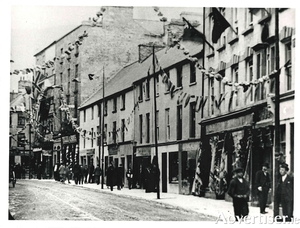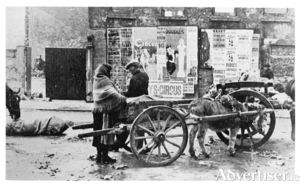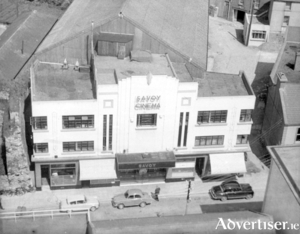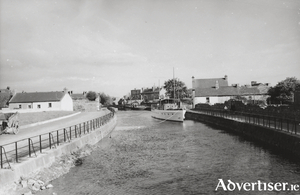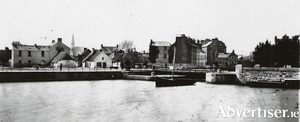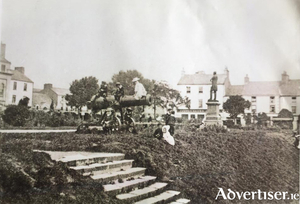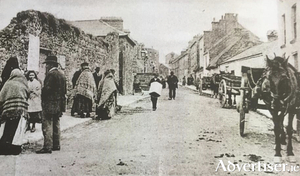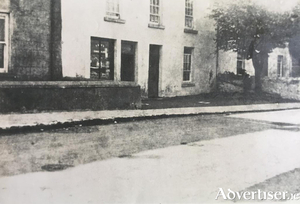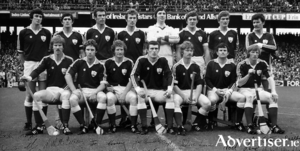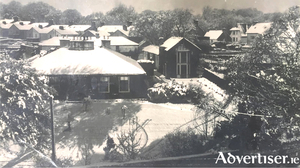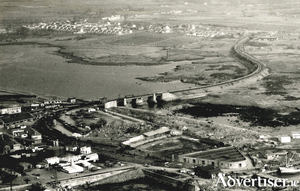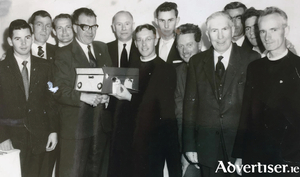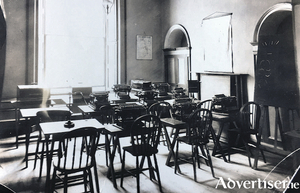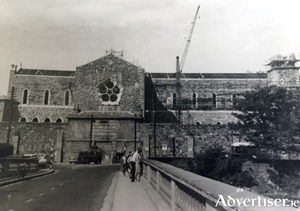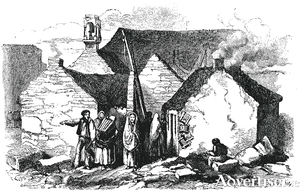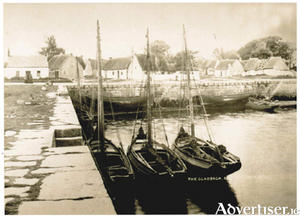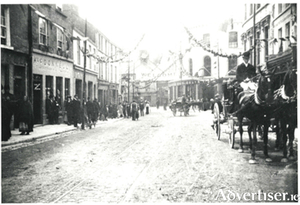Shop Street, 1903
Thu, Jul 30, 2020
This was Shop Street, Galway’s main street, decorated for the visit of Edward VII in 1903. The poles along the footpath were especially erected to carry bunting and decorations and many buildings had their own flags and other forms of decoration. It was a big occasion in the city. The prince came into the station on the railway from Clifden, was taken by horse and carriage around the Square, through the streets, and around by Raven Terrace and back to the Docks where his royal yacht was waiting.
Read more ...Going to market
Thu, Jul 23, 2020
“Every Saturday morning a procession of donkey-carts set out, nose to tail, for the market in Galway. This took place in the triangular patch by the Collegiate Church of St Nicholas. It dates from 1320 and was dedicated to St Nicholas, the patron saint of sailors, who was chosen then as the patron saint of Galway. There the donkeys were unharnessed and tethered to a wheel, the shafts were let down to the ground and the goods to be sold were displayed on the sloping cart. Vendors came from many more prosperous areas and their wares were a source of envy to those who lived in the congested strip along the coast. Eggs in big wicker baskets with hinged lids, ducks, hens and chickens, wooden kegs of buttermilk, home churned butter laid in rolls on cabbage-leaves, cabbages, onions, sometimes geese, hand-knitted socks – all sold briskly throughout the morning to the people of the town.
Read more ...The Savoy Cinema
Thu, Jul 16, 2020
In 1933, plans had been completed and passed by the Galway Urban District Council for a new cinema to be built on Eglinton Street by the famous baritone, Mr Walter McNally. “The building will be beautiful and imposing, designed on the most up-to-date lines. The theatre will have seating for over 800 on the ground floor while the balcony will be capable of holding over 300.”
Read more ...Middle Street, c1920
Thu, Jul 09, 2020
Our photograph shows Olly Shea from High Street with his two cousins, the Brays from Father Griffin Road. They are standing in Middle Street which looks very wide with nothing parked there. The building on the far left was a tenement which later became a timber yard. Next door was a store which was owned by O’Gormans. The building beside that, with the white gable, was Tim Murphy’s; he ran a second-hand clothes shop there and carded wool. Next door was another tenement which was later taken over by Corbett’s timber yard.
Read more ...Students rolling in money
Thu, Jul 02, 2020
In 1961 a group of 11 students from UCG decided to roll a barrel from Galway to Dublin and to collect money for the relief of famine and suffering in the Congo on the way. They wanted to roll the barrel, but the bands fell off before they got to St Patrick’s Church, so they borrowed an old pram from someone.
Read more ...The castle of Tír Oileáin
Thu, Jun 25, 2020
The Library of Congress in Washington gave us this 1913 photograph of the ruins of the castle of Tír Oileáin, or Tirellan, sometimes wrongly referred to as Terryland, and now generally known as Oldcastle. It was strategically very important as it commanded the river at a point where there was a ford. It was a De Burgh castle.
Read more ...The last boat to use the canal
Thu, Jun 18, 2020
On March 8, 1848, work was started on the Eglinton Canal. The Harbour Commissioners had been anxious to develop the New Dock. There were about 300 boats in the Claddagh and the amount of seaweed landed for manure in the spring of 1845 was 5,000 boat loads, averaging three tons each. The seaweed factory had been moved up to ‘The Iodine’, so the work on the canal was vital. It would allow boats to go from the Claddagh Basin up to the lake, boats from Cong and Maam to get to the sea, and improve the mill-power on the Galway River.
Read more ...The Claddagh Basin
Thu, Jun 11, 2020
The actual cutting of what we now know as The Eglinton Canal began in March 1848. It provided much needed work during the Famine. It began at the Corrib Club and entered the sea near the Claddagh Church. The filling they dug out was used to fill terraces in UCG (which was also being built at the time) and to fill in the causeway behind Claddagh Quay. The Claddagh Basin and the Claddagh Quays were constructed to cater for the 300 boats which were operating out of the Claddagh at the time.
Read more ...The guns in the Square
Thu, Jun 04, 2020
The Galway Vindicator of July 25, 1857, reported the arrival in Galway on board the SS Lady Eglinton, of two cannon, which had been shipped from Woolwich Arsenal, the main storage and distribution depot of Crimean War ordnance. These cannon, described as “64-pounders of a heavy and clumsy description, each weighing two tons,” were taken from the docks to the goods yard beside the railway station, where they were made ready for the handing over ceremony. They were part of a significant amount of Russian ordnance which had been captured in 1854 by the 88th Regiment at the Battle of Inkerman during the Crimean War. They were two of a number of artillery pieces that were presented by the war department to various cities as trophies.
Read more ...Eyre Street at the turn of the century
Thu, May 28, 2020
Edward Eyre arrived in Galway with the Cromwellian army, became a major political figure, and secured extensive grants from the Corporation and a considerable amount of property in both the city and county, mostly from displaced Catholic families, in the period 1660 to 1670. Most of this property was outside the town walls and included areas that we now know as the railway station, Forthill Cemetery, Victoria Place, Merchants Road, the Commercial Dock, Woodquay, Suckeen, and Eyre Square.
Read more ...Salthill village, 1920
Thu, May 21, 2020
It is hard to believe that this is what the centre of Salthill village looked like exactly 100 years ago. The house on the left belonged to a Mr Kelleher who was a member of the RIC. It later became a guest house called the Rockville which eventually expanded into a small hotel and, like many such premises in Salthill, it was fully licensed. It had high standards, the porter always wore a white coat and the waitresses wore proper uniforms. The distinguished writer Donal Mac Amhlaigh worked here for a while during the fifties.
Read more ...A memorable day for Galway
Thu, May 14, 2020
It was a joy to be a Galway person on the first Sunday of September 1980, the day our hurlers ended years of frustration, perennial underachievement, near misses, noble defeats, controversial defeats, the hard luck stories, the emptiness.
Read more ...Nile Lodge
Thu, May 07, 2020
The beginning of Salthill was the crossroads at Nile Lodge which linked Palmyra Crescent with New Line, Taylor's Hill, and Bóthar na Trá. Nile Lodge is an early 19th century house of a single storey built over a basement. It was reputedly built by an officer in Nelson’s Fleet who took part in the Battle of the Nile. The interior is designed like a bridge on board ship.
Read more ...Walking the Line
Thu, Apr 30, 2020
Walking the Line is the title of an important book written by Kevin Brophy which describes his childhood growing up in Renmore Barracks. The ‘Line’ is the path alongside the railway line on the causeway between the barracks and the station, and is seen in our photograph c1960.
Read more ...The Street Leagues
Thu, Apr 23, 2020
In the early 1950’s, a group of people calling themselves Coiste na n-Óg came together to try to improve the standard of Gaelic games in the city and they came up with the idea of a streets league. They divided up the city into sections and their teams were named as follows: St Anthony’s represented Newcastle; Western Stars was the name given to the team drawn from Father Griffin Road, Dominick Street, Henry Street, and ‘The West’; “98s” were from Bohermore/Woodquay, they were named after a famous Bohermore 98s team who were established in 1898, the centenary of 1798; Father Lally’s represented Shantalla, so named after a 19th century progressive charismatic parish priest of Rahoon; St Nicholas’ was the name given to the Claddagh teams; The boys from Salthill were simply known as Salthill. The lads from the Industrial School in Lower Salthill were known as St. Joseph’s they played in the under-14 league as did Club Mhuire and Naomh Pádraic
Read more ...West House, a brief history
Thu, Apr 16, 2020
West House was a large detached residence with extensive grounds in Helen Street. It had spacious rooms and belonged for a time to Admiral French.
Read more ...Galway Cathedral
Thu, Apr 09, 2020
In 1939, the Government decided there was no longer need for a jail in Galway. Galway County Council then decided to transfer the site of the jail to the Bishop of Galway for a nominal sum as a site for the erection of a cathedral.
Read more ...An account book of the Dominicans in the Claddagh 1727-1738
Thu, Apr 02, 2020
In 1698, the Dominican Community in the Claddagh were dispersed and exiled under a general exile of religious orders but within a few years, three of the friars had returned. It was the time of the Penal Laws, but gradually the pressure on these fathers eased, thanks largely to the refusal of the mayor and sheriffs to implement the anti-Catholic mandate of the English government. The priests were back in the Claddagh, tolerated by the officials.
Read more ...Claddagh fishermen
Thu, Mar 26, 2020
When the Claddagh fishermen worked, they did it with a will, and when not fishing, they were generally found mending their nets. They had the reputation of being so well prepared for sea, that lives were seldom lost when they went fishing. The strand often presented a lively sight at The Claddagh preparatory to the men proceeding to sea. They usually brought with them some oatmeal cakes, potatoes, water, and firing, no spirits of any kind.
Read more ...Williamsgate Street, 1903
Thu, Mar 19, 2020
The recent royal visit of William and Kate prompted us to dig out this photograph of Williamsgate Street taken in August 1903. It was taken just before or after King Edward VII and Queen Alexandra passed through. There were more banners and flags up while they were in the vicinity. The Royals had sailed into Killary Harbour on the royal yacht, then toured Connemara and then travelled by train to Galway. Their visit here was full of pomp and ceremony.
Read more ...